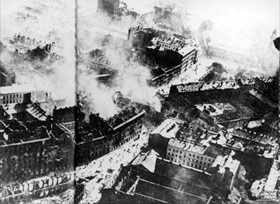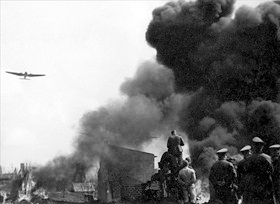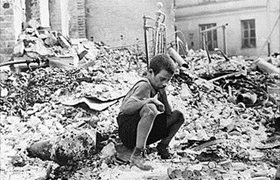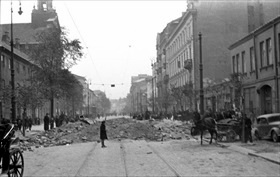LUFTWAFFE PREPARES FINAL TERROR BOMBING OF WARSAW
Forward German HQ in Poland • September 24, 1939
On this date in 1939 in Poland, Luftwaffe chief Hermann Goering prepared to send hundreds of aircraft to blitz Warsaw in the largest air raid ever up to that time, while German armored forces prepared for a ground assault on the Polish capital. At 8 a.m. the next day, September 25, known as “Black Monday” in Poland, German airplanes, including some that were obsolete, conducted 1,150 sorties over the city, dropping 560 tons of high-explosive bombs and 72 tons of incendiary bombs. In doing so, Germany shifted the terror bombing of civilian populations into overdrive following Axis experiments on Guernica (1937) and Barcelona (1938) during the Spanish Civil War.
Lt. Col. Wolfram von Richthofen, who was in charge of the Guernica air raid, declared the bombing and strafing of that Spanish town, which may have killed over 1,500 people out of a population of 7,000, to have been “a complete technical success” and broke the survivors’ morale. Richthofen employed the same bombing techniques in Poland with greater intensity and to much greater effect. The “Black Monday” bombing ruptured Warsaw’s water pipes and prevented the inferno from being quenched, elating Richthofen who wanted to burn the capital to the ground and turn it into a mere “customs station” in the future. Between aerial and artillery bombardments, 40 percent of the city’s buildings were damaged and 10 percent destroyed. Over 75,000 civilians became casualties before the Polish capital of 1.1 million people (1931 population) surrendered on September 27, 1939. The Germans took over 100,000 prisoners.
The Luftwaffe next firebombed Rotterdam in the Netherlands, this on May 14, 1940, killing 1,000 residents and leaving 78,000 homeless, even though the Dutch city had already capitulated. Quickening the tempo, Germany carried out incendiary raids on an ever larger scale with nighttime attacks on the Midlands city of Coventry and the British capital, London, in 1940–1941 (Blitz).
Incendiary bombing of heavily populated European cities was ratcheted up again when the Allies (chiefly in the form of the Royal Air Force) virtually destroyed the North German city of Hamburg in mid-1943 air raids that killed about 50,000 people out of a population of 1.2 million. The Hamburg “area bombing,” or carpet bombing, of Germany’s second-largest city was a deliberate attack on civilian morale and did little to damage the Nazis’ war machine in contrast to America’s “precision bombing” of German military and industrial targets such as aircraft, shipbuilding, synthetic oil refineries, and transportation system, which inflicted major disruptions on the German military and economy reputedly with fewer civilian casualties. (Postwar critics of the Anglo-American bombing campaign against Nazi Germany maintain that the difference between an RAF area bombing raid and a U.S. “precision bombing” raid was often minimal.)
Three months before Germany’s surrender in May 1945, 1,300 U.S. and British heavy bombers unleashed 4,000 tons of bombs on Dresden, destroying 15 square miles of that historic city in a conflagration that killed some 25,000 people. Half a world away, Japan’s capital, Tokyo, was the worst-ravaged of any firebombed city when on March 9–10, 1945, 90,000 civilians were killed outright and 40,000 later died when U.S. napalm-filled “block burners” spread a fire typhoon through the city. Paradoxically, fewer Japanese died in each of the atomic blasts over Hiroshima and Nagasaki later that August than in Tokyo on March 9–10, 1945.
![]()
Terror Bombing Warsaw: The Luftwaffe’s Aerial Bombardment Campaign of 1939
 |  |
Left: Burning Warsaw, September 1939. The Luftwaffe opened the German attack on Poland’s capital on September 1, 1939. As German armored units approached Warsaw on September 8 and 10, Junkers Ju‑87 Stukas and bombers attacked the city, the slow-speed Stukas strafing civilians as they flew over the city. On the 13th, Luftwaffe bombers caused widespread fires. On September 25 Luftwaffe bombers, in coordination with heavy artillery shelling, dropped 632 high-explosive and incendiary bombs that badly damaged Warsaw’s city center.
![]()
Right: Under aerial cover German forces entered Warsaw on September 27, 1939, after three key forts in the city defenses were captured and the Polish garrison surrendered. After the capitulation approximately 5,000 officers and 97,000 soldiers and NCOs were taken into captivity, many never to be seen again.
 |  |
Left: From the first hours of the war, Warsaw was the target of an unrestricted aerial bombardment campaign, and the Luftwaffe used all available aircraft in its inventory. Apart from the military facilities such as infantry barracks, the airport, and an aircraft factory, German pilots also targeted civilian facilities such as water works, hospitals, market places, and schools in an effort to terrorize the city’s defenders into surrendering. Amid the waste and destruction of violent bombardment and artillery shelling, the nine-year-old boy in this photo takes time out from a search for food for his family. His father, later taken away by the Nazis, never returned.
![]()
Right: Between air and ground assaults in September 1939, Warsaw suffered 25,800 civilian deaths, while approximately 50,000 were wounded. Forty percent of the city’s buildings were damaged and 10 percent destroyed. The terror bombing of the Polish capital played a key role in the country’s defeat. The Polish Army lost approximately 6,000 killed in action and 16,000 wounded in what Poles call the Polish Defensive War of 1939. As courageously as they fought, the Poles were simply outmatched by the more modern Wehrmacht (German armed forces). German casualties are estimated at 1,500 dead and 5,000 wounded. In the course of the nearly six-year-long conflict in Poland close to 85 percent of Warsaw was destroyed, in part due to mass aerial bombings and heavy artillery fire by opposing German and Soviet forces in 1944–1945, and the demolition campaign by vengeful Germans against the capital’s inhabitants who had staged an unsuccessful uprising between August and the first three days of October 1944.
U.S. War Department Film Documenting September 1939 Invasion of Poland
![]()

 History buffs, there is good news! The Daily Chronicles of World War II is now available as an ebook for $4.99 on Amazon.com. Containing a year’s worth of dated entries from this website, the ebook brings the story of this tumultuous era to life in a compelling, authoritative, and succinct manner. Featuring inventive navigation aids, the ebook enables readers to instantly move forward or backward by month and date to different dated entries. Simple and elegant! Click
History buffs, there is good news! The Daily Chronicles of World War II is now available as an ebook for $4.99 on Amazon.com. Containing a year’s worth of dated entries from this website, the ebook brings the story of this tumultuous era to life in a compelling, authoritative, and succinct manner. Featuring inventive navigation aids, the ebook enables readers to instantly move forward or backward by month and date to different dated entries. Simple and elegant! Click 











